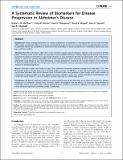Files in this item
A systematic review of biomarkers for disease progression in Alzheimer's disease
Item metadata
| dc.contributor.author | McGhee, David J. M. | |
| dc.contributor.author | Ritchie, Craig W. | |
| dc.contributor.author | Thompson, Paul A. | |
| dc.contributor.author | Wright, David E. | |
| dc.contributor.author | Zajicek, John P. | |
| dc.contributor.author | Counsell, Carl E. | |
| dc.date.accessioned | 2016-09-14T10:30:09Z | |
| dc.date.available | 2016-09-14T10:30:09Z | |
| dc.date.issued | 2014-02-18 | |
| dc.identifier | 242546307 | |
| dc.identifier | b8824467-6598-4157-ba90-ecaa6f83f4a7 | |
| dc.identifier | 24558437 | |
| dc.identifier | 84895888957 | |
| dc.identifier.citation | McGhee , D J M , Ritchie , C W , Thompson , P A , Wright , D E , Zajicek , J P & Counsell , C E 2014 , ' A systematic review of biomarkers for disease progression in Alzheimer's disease ' , PLoS One , vol. 9 , no. 2 , e88854 . https://doi.org/10.1371/journal.pone.0088854 | en |
| dc.identifier.issn | 1932-6203 | |
| dc.identifier.other | ORCID: /0000-0003-3481-825X/work/64034662 | |
| dc.identifier.uri | https://hdl.handle.net/10023/9496 | |
| dc.description | This article presents independent research funded by the National Institute for Health Research (NIHR) under its Programme Grants for Applied Research Programme (Grant Reference Number RP-PG-0707-10124). | en |
| dc.description.abstract | BACKGROUND: Using surrogate biomarkers for disease progression as endpoints in neuroprotective clinical trials may help differentiate symptomatic effects of potential neuroprotective agents from true slowing of the neurodegenerative process. A systematic review was undertaken to determine what biomarkers for disease progression in Alzheimer's disease exist and how well they perform. METHODS: MEDLINE and Embase (1950-2011) were searched using five search strategies. Abstracts were assessed to identify papers meriting review in full. Studies of participants with probable Alzheimer's disease diagnosed by formal criteria were included. We made no restriction on age, disease duration, or drug treatment. We only included studies with a longitudinal design, in which the putative biomarker and clinical measure were both measured at least twice, as this is the only appropriate study design to use when developing a disease progression biomarker. We included studies which attempted to draw associations between the changes over time in the biomarker used to investigate disease progression and a clinical measure of disease progression. RESULTS: Fifty-nine studies were finally included. The commonest biomarker modality examined was brain MRI (17/59, 29% of included studies). Median follow-up in included studies was only 1.0 (IQR 0.8-1.7) year and most studies only measured the putative biomarker and clinical measure twice. Included studies were generally of poor quality with small numbers of participants (median 31 (IQR 17 to 64)), applied excessively restrictive study entry criteria, had flawed methodologies and conducted overly simplistic statistical analyses without adjusting for confounding factors. CONCLUSIONS: We found insufficient evidence to recommend the use of any biomarker as an outcome measure for disease progression in Alzheimer's disease trials. However, further investigation into the efficacy of using MRI measurements of ventricular volume and whole brain volume appeared to be merited. A provisional 'roadmap' to improve the quality of future disease progression biomarker studies is presented. | |
| dc.format.extent | 9 | |
| dc.format.extent | 290867 | |
| dc.language.iso | eng | |
| dc.relation.ispartof | PLoS One | en |
| dc.subject | Alzheimer's disease | en |
| dc.subject | Biomarkers | en |
| dc.subject | Disease progression | en |
| dc.subject | Humans | en |
| dc.subject | RC0321 Neuroscience. Biological psychiatry. Neuropsychiatry | en |
| dc.subject.lcc | RC0321 | en |
| dc.title | A systematic review of biomarkers for disease progression in Alzheimer's disease | en |
| dc.type | Journal article | en |
| dc.contributor.institution | University of St Andrews. School of Medicine | en |
| dc.identifier.doi | 10.1371/journal.pone.0088854 | |
| dc.description.status | Peer reviewed | en |
This item appears in the following Collection(s)
Items in the St Andrews Research Repository are protected by copyright, with all rights reserved, unless otherwise indicated.

